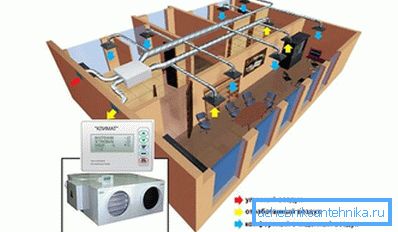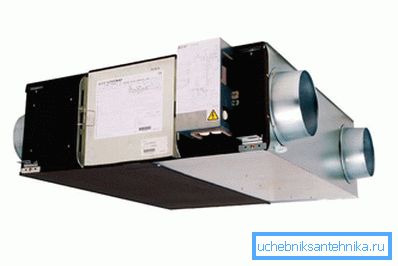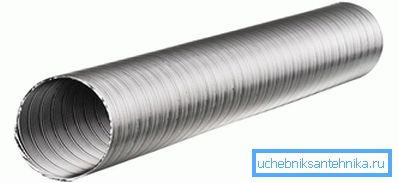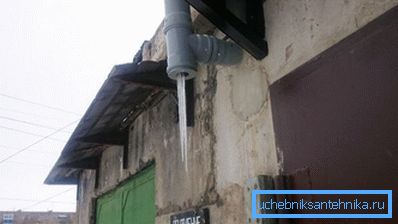Ventilation from the sewer pipe itself
Oxygen plays a vital role in human life. This chemical element must be sufficiently supplied to the living quarters and the ventilation system is designed to cope with this task. In addition to the delivery of fresh air, these communications are necessary to remove unpleasant odors and harmful gases from the house or apartment. To create such systems, special pipes are used, but if they are not at hand, you can use their counterparts. In this article, it will be discussed just about one such kind of system, or rather, about how the ventilation is made from sewage pipes with their own hands.
A little bit about the ventilation itself

Before you begin the story about how to create a ventilation system in a private house, you should get acquainted with the very concept. According to the existing standards (simplified calculation), there should be 30 cubic meters of fresh air per person living in a house or apartment. It is for this air exchange and the ventilation system is necessary.
The principle of operation of such systems is quite simple. From the so-called "dirty" rooms it is necessary to provide air exhaust. Such premises include a kitchen, toilet, bathroom, etc. But in clean rooms (bedroom, hall, living room, etc.) it is necessary to provide fresh air.
The ventilation system itself can be divided into two types:
- natural;
- forced

The easiest is natural ventilation. Such systems are most often installed in apartments, in private and country houses, in the garage and other premises. For the operation of natural ventilation in the bathroom, kitchen and bathroom install vertical channels that are displayed on the roof. It is on them that the outflow of “used” air from the premises occurs.
Ventilation shafts are usually made during the construction of a house. Most often in the design of the so-called "dirty" rooms are located closer to each other. It is necessary that their mines pass by and are displayed near the ridge of the roof. This feature is necessary to ensure good traction, because it is known that the higher the pipe, the better the gases are drawn through it.
In frame and wooden houses there is no need to apply brickwork specifically for ventilation shafts. Plastic pipes can be used in such constructions. They do the same when creating a natural ventilation system in homes that have already been built, where mines were not built.
In the forced ventilation system, except for the pipes and shafts themselves, fans are used. They are designed to pump air. At the same time, such systems can be as inflow (to supply air from the street to the premises), and exhaust (to provide reverse air flow).

As a rule, the forced ventilation system is performed using various special pipes. They can be both round and rectangular in shape. Pipes are supplied to each room and provide air exchange.
In addition to these two main systems, there is another one - local forced ventilation. In this case, special devices are used that provide air purification in the room and replace it with fresh air from the street.
Local ventilation systems do not require pipes. Such devices are installed in the room and connected to the street with small holes. The installation itself has all the necessary accessories. Here can be installed:
- filters;
- fans;
- recuperators;
- heaters;
- ionizers, etc.
In fact, this is a real ventilation system, only in miniature.
What pipes are used

To create a ventilation system, you can use a large range of pipes. The choice is entirely dependent on the owner of the house. If the system itself was planned during construction, then, as a rule, they are simply constructed from the brickwork of the mine. Through them the air comes out of the kitchen, bathroom and bathroom.
When creating a forced ventilation system, the use of pipes is simply necessary. In this case, you can use the products:
- Made of metal. Such pipes are durable and not afraid of fire. But they have a significant drawback - it is a big noise. If the system uses a fan, the noise from its work can be heard in all rooms. In addition, metal pipes are prone to corrosion and are able to accumulate static electricity;
- From plastic. Such material is relatively recently used in ventilation systems. As a rule, for these purposes polyvinyl chloride or polyurethane of hard and medium type is used. Such products are light, have sufficient strength, do not conduct noise and do not accumulate electricity. In addition, an absolutely smooth inner surface does not allow dust to accumulate and passes air masses well. The disadvantage of such pipes can be considered an increased fire hazard. Of course, polyvinyl chloride does not burn, but when strongly heated, it releases toxic gases.

In addition to various materials, pipes for ventilation systems may differ in their shape and diameter. During installation, you can use round or rectangular structures. The first option conducts air better, but square pipes are easier to install.
If we talk about the diameter of the ventilation pipes, then everything will depend on the power of the system itself. More precisely, on how much air must be pumped. Most often, pipes with a diameter of 110 mm are quite suitable for domestic or household ventilation.
Advantages and disadvantages

If you decide to use sewer pipes for the ventilation system, you should know the pros and cons of such a step. The positive aspects include the following:
- minimization of expenses. Sewage pipes are much cheaper than their special ventilation counterparts;
- large selection of fittings. With their help, you can easily make a system of almost any configuration;
- low weight;
- resistance to corrosion and corrosive environments;
- sufficient strength and durability.
But, despite such a large number of advantages, experts, nevertheless, do not recommend using sewer pipes in the ventilation system. There are a number of objective reasons for this. First, such products do not have a sufficient degree of fire safety. Of course, they are unlikely to catch fire, but they are quite capable of releasing harmful gas to the room. Secondly, the use of sewer pipes in the ventilation system does not allow sanitary standards. It is connected all with the same toxic gases.
Therefore, the use of this material for ventilation of residential buildings is undesirable. But for the garage or other non-residential premises, they will fit perfectly.
The principle of installation of ventilation from such pipes is not much different from the creation of the sewer system itself. Pipes are attached to the ceiling and connected to each other with fittings of the required diameter. All pipelines are connected in one (or several) places, preferably located at the highest point. Then the pipe is displayed on the roof, as high as possible from the level of the roof. Do not forget to make holes in the pipes inside the rooms for air passage and fix the pipeline itself to the wall or ceiling using clamps.
Video
Natural ventilation in a temporary yard from sewer pipes: